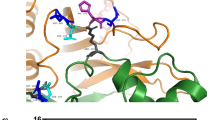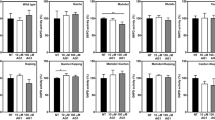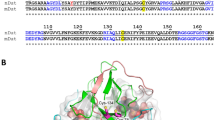Abstract
Glucose-6-phosphate dehydrogenase (G6PD) catalyzes the first step of the pentose phosphate pathway. In erythrocytes, the functionality of the pathway is crucial to protect these cells against oxidative damage. G6PD deficiency is the most frequent enzymopathy in humans with a global prevalence of 4.9 %. The clinical picture is characterized by chronic or acute hemolysis in response to oxidative stress, which is related to the low cellular activity of G6PD in red blood cells. The disease is heterogeneous at genetic level with around 160 mutations described, mostly point mutations causing single amino acid substitutions. The biochemical studies aimed to describe the detrimental effects of mutations on the functional and structural properties of human G6PD are indispensable to understand the molecular physiopathology of this disease. Therefore, reliable systems for efficient expression and purification of the protein are highly desirable. In this work, human G6PD was heterologously expressed in Escherichia coli and purified by immobilized metal affinity chromatography in a single chromatographic step. The structural and functional characterization indicates that His-tagged G6PD resembles previous preparations of recombinant G6PD. In contrast with previous protein yield systems, our method is based on commonly available resources and fully accessible laboratory equipment; therefore, it can be readily implemented.





Similar content being viewed by others
Abbreviations
- G6PD:
-
Glucose-6-phosphate dehydrogenase
- IMAC:
-
Immobilized metal affinity chromatography
- LB:
-
Luria-Bertani
- TB:
-
Terrific Broth
- TEVP:
-
Tobacco etch virus protease
- IPTG:
-
Isopropyl-1-thio-β-d-galactopyranoside
- G6P:
-
Glucose-6-phosphate
- CD:
-
Circular dichroism
References
Au SWN, Gover S, Lam VMS, Adams M (2000) Human glucose-6-phosphate dehydrogenase: the crystal structure reveals a structural NADP+ molecule and provides insights into enzyme deficiency. Structure 8:293–303
Bautista JM, Mason PJ, Luzzatto L (1992) Purification and properties of human glucose-6-phosphate dehydrogenase made in E. coli. Biochim Biophys Acta 1119:74–80
Bautista JM, Mason PJ, Luzzatto L (1995) Human glucose-6-phosphate dehydrogenase. Lysine 205 is dispensable for substrate binding but essential for catalysis. FEBS Lett 366:61–64
Betke K, Beutler E, Brewer GJ, Kirkman HN, Luzzatto L, Motulsky AG, Ramot B, Siniscalco M (1967) Standardization of procedures for the study of glucose-6-phosphate dehydrogenase. World Health Organ Tech Rep Ser 366:1–53
Beutler E (1990) The genetics of glucose-6-phosphate dehydrogenase deficiency. Semin Hematol 27:137–164
Cappellini D, Fiorelli G (2008) Glucose-6-phosphate dehydrogenase deficiency. Lancet 9606:64–74
Enríquez-Flores S, Rodríguez-Romero A, Hernández-Alcántara G, Oria-Hernández J, Gutiérrez-Castrellón P, Pérez-Hernández G, de la Mora-de la Mora I, Castillo-Villanueva A, García-Torres I, Méndez ST, Gómez-Manzo S, Torres-Arroyo A, López-Velázquez G, Reyes-Vivas H (2011) Determining the molecular mechanism of inactivation by chemical modification of triosephosphate isomerase from the human parasite Giardia lamblia: a study for antiparasitic drug design. Proteins 79:2711–2724
Gómez-Gallego F, Garrido-Pertierra A, Mason PJ, Bautista JM (1996) Unproductive folding of the human G6PD-deficient variant A-. FASEB J 10:153–158
Gomez-Gallego F, Garrido-Pertierra A, Bautista JM (2000) Structural defects underlying protein dysfunction in human glucose-6-phosphate dehydrogenase A- deficiency. J Biol Chem 275:9256–9262
Grabowska D, Jablonska-Skwiecinska E, Plochocka D, Chelstowska A, Lewandowska I, Witos I, Majewska Z, Rokicka-Milewska R, Burzynska B (2004) A novel mutation in the glucose-6-phosphate dehydrogenase gene in a subject with chronic nonspherocytic hemolytic anemia–characterization of enzyme using yeast expression system and molecular modeling—characterization of enzyme using yeast expression system and molecular modeling. Blood Cells Mol Dis 32:124–130
Huang Y, Choi MY, Au SW, Au DM, Lam VMS, Engel PC (2008) Purification and detailed study of two clinically different human glucose 6-phosphate dehydrogenase variants, G6PD(Plymouth) and G6PD(Mahidol): evidence for defective protein folding as the basis of disease. Mol Genet Metab 93:44–53
Kotaka M, Gover S, Vandeputte-Rutten L, Au SWN, Lam VMS, Adams MJ (2005) Structural studies of glucose-6-phosphate and NADP+ binding to human glucose-6-phosphate dehydrogenase. Acta Crystallogr D Biol Crystallogr 61:496–504
Lowry OH, Rosebrough NJ, Farr AL, Randall RJ (1951) Protein measurement with the Folin phenol reagent. J Biol Chem 193:265–275
Luzzatto L, Mehta A, Vulliamy TJ (2001) In: Scriver CR, BeaudetAL, Sly WS, Valle D (eds) The metabolic and molecular bases of inherited disease, 8th ed. McGraw-Hill, New York
Mason PJ, Bautista JM, Gilsanz F (2007) G6PD deficiency: the genotype-phenotype association. Blood Rev 5:267–283
Minucci B, Giardina C, Zuppi E (2009) Glucose-6-phosphate dehydrogenase laboratory assay: how, when, and why? IUBMB Life 61:27–34
Nkhoma ET, Poole C, Vannappagari V, Hall SA, Beutler E (2009) The global prevalence of glucose-6-phosphate dehydrogenase deficiency: a systematic review and meta-analysis. Blood Cells Mol Dis 42:267–278
Persico MG, Viglietto G, Martini G, Toniolo D, Paonessa G, Moscatelli C, Dono R, Vulliamy T, Luzzatto L, D’Urso M (1986) Isolation of human glucose 6-phosphate dehydrogenase (G6PD) cDNA clones: primary structure of the protein and unusuall 50 non-coding region. Nucleic Acids Res 14:2511–2522
Sambrook J, Fritsch EF, Maniatis T (1989) Molecular cloning. A Laboratory Manual Cold Spring Harbor, New York
Schneider CA, Rasband WS, Eliceiri KW (2012) NIH Image to ImageJ: 25 years of image analysis. Nat Methods 9:671–675
Scopes DA, Bautista JM, Naylor CE, Adams MJ, Mason PJ (1998) Amino acid substitutions at the dimer interface of human glucose-6-phosphate dehydrogenase that increase thermostability and reduce the stabilising effect of NADP. Eur J Biochem 251:382–388
Tang TK, Yeh CH, Huang CS, Huang MJ (1994) Expression and biochemical characterization of human glucose-6-phosphate dehydrogenase in Escherichia coli: a system to analyze normal and mutant enzymes. Blood 83:1436–1441
Wang XT, Au SWN, Lam VMS, Engel PC (2002) Recombinant human glucose-6-phosphate dehydrogenase. Evidence for a rapid-equilibrium random-order mechanism. Eur J Biochem 269:3417–3424
Wang XT, Lam VM, Engel PC (2005) Marked decrease in specific activity contributes to disease phenotype in two human glucose 6-phosphate dehydrogenase mutants, G6PD (Union) and G6PD (Andalus). Hum Mutat 26:284–293
Wang XT, Lam VMS, Engel PC (2006) Functional properties of two mutants of human glucose 6-phosphate dehydrogenase, R393G and R393H, corresponding to the clinical variants G6PD Wisconsin and Nashville. Biochim Biophys Acta 1762:767–774
Wang XT, Chan TF, Lam V, Engel P (2008) What is the role of the second “structural” NADP+-binding site in human glucose-6-phosphate dehydrogenase? Protein Sci 17:1403–1411
Wang XT, Engel PC (2009) Clinical mutants of human glucose 6-phosphate dehydrogenase: impairment of NADP(+) binding affects both folding and stability. Biochim Biophys Acta 1792:804–809
Acknowledgments
SGM is supported by Consejo Nacional de Ciencia y Tecnología Grant 154570. JOH is supported by Consejo Nacional de Ciencia y Tecnología Grant 106126. HRV is supported by Consejo Nacional de Ciencia y Tecnología Grant 104841. The technical assistance of Carmen Ortiz is greatly appreciated.
Conflict of interest
The authors declare no conflict of interest.
Author information
Authors and Affiliations
Corresponding author
Rights and permissions
About this article
Cite this article
Gómez-Manzo, S., Terrón-Hernández, J., de la Mora-de la Mora, I. et al. Cloning, Expression, Purification and Characterization of His-Tagged Human Glucose-6-Phosphate Dehydrogenase: A Simplified Method for Protein Yield. Protein J 32, 585–592 (2013). https://doi.org/10.1007/s10930-013-9518-x
Published:
Issue Date:
DOI: https://doi.org/10.1007/s10930-013-9518-x




